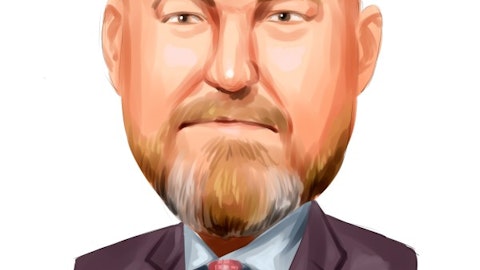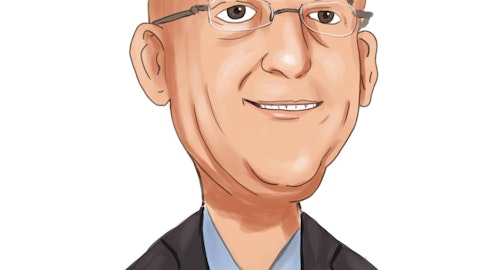Federated Hermes, Inc. (NYSE:FHI) Q4 2022 Earnings Call Transcript January 27, 2023
Operator: Good day and welcome to the FHI Q4 2022 Analyst Call and Webcast. At this time, all participants have been placed on a listen-only mode. It is now my pleasure to turn the floor over to your host, Ray Hanley, President of Federated Investors Management Company. Sir, the floor is yours.
Ray Hanley: Good morning, and welcome. Leading today’s call will be Chris Donahue, Federated Hermes’ CEO and President; Tom Donahue, Chief Financial Officer. And joining us for the Q&A are Saker Nusseibeh, who is the CEO of Federated Hermes Limited; and Debbie Cunningham, our Chief Investment Officer for Money Markets. Today’s call, we will make forward-looking statements and we want to note that Federated Hermes’ actual results may be materially different than the results implied by such statements. Please review our risk disclosures in our SEC filings. No assurance can be given as to future results and Federated Hermes assumes no duty to update any of these forward-looking statements. Chris?
Chris Donahue: Thank you Ray, and good morning all. I will review Federated Hermes’ business performance, Tom will comment on our financial results. We ended 2022 with record total assets under management of 669 billion. This was driven by growth of 35.6 billion in money market assets in Q4 to reach a record high of 477 billion at year-end. Turning to equities. Assets increased by about 7 billion to 81.5 billion due to market gains, FX impact, and net positive sales in separate accounts, all of which were partially offset by net fund redemptions. The strategic value dividend strategy continued to produce solid net sales with nearly $1 billion in the Q4 with about a quarter of that from the fund, and almost three quarters of that from the SMA.
The U.S. Strategic Value Dividend ETF launched in mid-November now has 42 million in assets. We saw Q4 positive net sales in 16 equity fund strategies, including Asia ex-Japan, International Strategic Value Dividend, MDT Large Cap Growth, European Alpha Equity, International Growth and Clover Small Value. Q4 equity fund net redemptions of were concentrated in our growth strategies. Our equity fund performance at the end of 2022, compared to peers was solid. Using Morningstar data for the trailing three years, at the end of the year, 61% of our equity funds were beating peers and 33% were in the top quartile of their category. As we begin 2023, our equity focus with clients continues to be on the strategies that have responded well in inflationary times.
These include dividend income, international, emerging markets, and value. Now, for the first three weeks of Q1, combined equity and SMAs had net positive sales of 328 million. We had 23 equity funds with positive net sales during this period, including Strategic Value Dividend, Global Emerging Markets, Asia ex-Japan, MDT Small Cap Core, and international leaders. Turning now to fixed income. Assets increased by about 1.3 billion in Q4 to 86.7 billion as assets from the CW Henderson acquisition of about 3.5 billion and gains from market values of about 1.6 billion were partially offset by net redemptions from funds of 2.6 billion and separate accounts of 1.3 billion. Within our funds, our flagship Core Plus strategy total return bond had Q4 net sales of about 652 million, benefiting from a long-term performance record.

Photo by Aidan Hancock on Unsplash
And that has led to expanded distribution opportunities. Our two Microshort bond funds combined for just under 200 million of Q4 net sales. Core Plus and other multi-sector fixed income SMA strategies added 146 million of Q4 net sales. Within fixed income funds, Q4 net redemptions of about 1.8 billion occurred in the three ultrashort funds. We had nine fixed income funds with positive net sales in the fourth quarter, including total return bond and two Microshorts as already mentioned, as well as institutional high yield bond fund and the intermediate corporate bond fund. Regarding performance, at the end of 2022 using Morningstar data for the trailing three years, 57% of our fixed income funds were beating peers and 16% were in the top quartile of their category.
For the first three weeks of 2023, fixed income funds and SMAs had net positive sales of 466 million led by total return bond and SDG engagement high yield credit. During the same period, we had 18 fixed income funds with positive net sales. Some of the others include: corporate bond, sterling cash plus, and institutional high-yield bond. In the alternative and private markets category, assets increased due to positive FX impact, partially offset by market losses and net redemptions. Pru Bear was up, MDT was up, and direct lending was up. These were offset by net redemptions in absolute return credit, private equity, and infrastructure. Now, we continue marketing the fifth vintage of P-E-C, PEC, our co-investment private equity structure and the third vintage of the Horizon Private Equity Fund.
PEC 5 has raised about 400 million through year-end and Horizon has commitments of a little over a billion through year-end. We begin 2023 with about 4.8 billion in net institutional mandates yet to fund into both funds and separate accounts. About 3 billion of this net total is expected to come into private market strategies, including private equity, direct lending, and unconstrained credit. Equity wins of about 1.3 billion are in Asia ex-Japan, Global Emerging Markets, Global Equities. Fixed income expected additions are in SDG high yield credit, investment grade credit and short duration. Moving to money markets. The Q4 asset increase reflected seasonality and favorable market conditions for cash as an asset class. Money market strategies are benefiting from higher yields, elevated liquidity levels in the financial system, and favorable yields compared to bank deposits.
We expect higher short-term rates will benefit money market funds over time, particularly as compared to deposit rates. Our money market mutual fund market share, including the sub advised funds was about 7.7% at the end of 2022, up from about 7.4% at the end of the third quarter of 2022. Looking now at recent asset totals as of a few days ago, managed assets were approximately 674 billion, including 475 billion in money markets, 90 billion in equities, 85 billion in fixed income, 21 billion in alternative private markets, and 3 billion in multi-asset. Money market mutual fund assets were 325 billion. Tom?
Tom Donahue: Thanks, Chris. Total revenue for Q4 decreased 7.2 million or about 2% from the prior quarter due mainly to lower average long-term assets and lower performance fees in carried interest, partially offset by higher average money market assets. Q4 performance fees and carried interests were 3.3 million. Q4 operating expenses increased 25.8 million or 9%, compared to Q3, driven by the 31.5 million non-cash intangible asset impairment charge, offset mainly by FX impact of 8 million from the currency forwards used to hedge certain pound exposure. The impairment charge was due to the change in fair value of one of the intangible assets from the 2018 Hermes Fund Managers Limited acquisition, representing about 6% of the total acquisition price.
The lower asset valuation was driven by changes in projected cash flows and a higher discount rate, compared to the prior quarter. In non-operating income, investment gains after subtracting the impact attributed to the non-controlling interest added earnings per share for the quarter of about $0.04, due to the positive impact of the market on the investments. Looking ahead to Q1, certain seasonal factors will impact results. The impact of fewer days is expected to result in about 6.4 million in lower operating income, excluding the impact of the impairment charge and with all else being equal. In addition, based on an early assessment, compensation and related expense could be $13 million higher than Q4, due primarily to about 9 million of seasonally higher expense for stock compensation and payroll taxes.
We also expect to have higher base pay, higher incentive compensation expense, and of course, all these amounts will vary based on multiple factors. The effective tax rate was lower in Q4, primarily related to a one-time recognition of a capital loss for tax purposes. Non-taxable, non-controlling interest income that’s included in our pretax income, but non-taxable to Federated Hermes and certain stock based compensation where we get a higher tax deduction when our stock price investing exceeds the price when the shares were granted. We expect our effective tax rate to be in the range of 24% to 26% in 2023. At the end of 2022, cash and investments were 522 million of which about 466 million was available to us. would now like to open the call up for questions.
See also 10 Dirt Cheap Stocks To Buy and 13 Cheap New Stocks To Buy.
Q&A Session
Follow Federated Hermes Inc. (NYSE:FHI)
Follow Federated Hermes Inc. (NYSE:FHI)
Receive real-time insider trading and news alerts
Operator: Certainly. Your first question for today is coming from Dan Fannon at Jefferies. Dan, your line is live.
Unidentified Analyst: Hi, good morning. This is actually Rick on for Dan. Just thinking about expenses, how should we think about the general trajectory for non-comp expenses? And also, kind of double clicking into that, I believe the other line, excluding the impairment charge was lower by approximately 5.5 million or around that range, compared to the last three quarters and a year-ago. Just wondering was that, sort of the FX impact, FX impact in the other direction that was called out or is this, sort of savings?
Chris Donahue: Yes. I’ll cover some of those, Ray will come in with a few more. So, I mentioned the comp already. So, all else being equal, we expect that to go up. Distribution, we would expect that to go up. We see that as the old days as success item, as we get more assets, distribution goes up, systems and communications, professional service fees, travel related, those all have inflation and price increases. All are expected to go up. And you would comment on the other?
Ray Hanley: Yes. Rick, you’re correct with the FX impact, and obviously, we saw pretty significant movement in the pound in Q3. And so, we had a net expense in that line item. And then for Q4 with the pound moving the other direction, we had a net credit that was the $80 million that we mentioned.
Unidentified Analyst: Got it. Appreciate that color. And then just on, sort of the higher expenses that you called out, could you point to maybe a pre-pandemic, sort of year or set of quarters that we can look at for general levels as a percent of revenues or is there a better way to think of that?
Ray Hanley: Yes. So, we don’t look at it like that at all. We just don’t calculate it based on that way and don’t think that way. We’re trying to raise assets what’s the best way to do it. And, like for T&E, the sales force believes they should be out there and you can see that trending up, and it’s trending up and they’re out there traveling more and it costs more to do it. But we don’t calculate the way you’re talking about.
Unidentified Analyst: Understood. Appreciate that. And if I could sneak one last question in there. In terms of long-term fee rate, just €“ and sort of the quarter to date, kind of flow discussion that was called out, how does the exit rate for the fourth quarter, kind of compared to the average? And how does that look like going into early January?
Chris Donahue: The fee rate really is a function of the blend of changes in assets. And so, you’ve seen, for example, in equity over the course of 2022 with growth assets being down, to say one example that would be a case where we would have higher than the average €“ higher than our average fee rates. In addition, we’ve had growth in €“ we called out the strategic value dividend, SMA. And SMAs of course have lower management fee rates than the mutual funds do. So, it’s really a function of the blend of where the average asset growth is occurring and looking at the first couple of weeks of 2023, I would say, we’re not going to see, I wouldn’t use that to forecast any material change in the fee rate. We’d want to cover some more ground before doing that. And they’re good solid wins in categories like high yield, multiple, most of the equity products producing net positive flows. And of course, we’ve had positive market impact. So, all of that goes to the good.
Unidentified Analyst: Thanks guys. Really appreciate the color.
Operator: Your next question for today is coming from Patrick Davitt at Autonomous Research. Patrick, your line is live.





